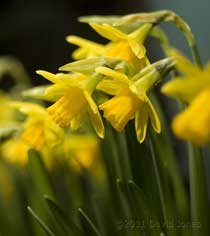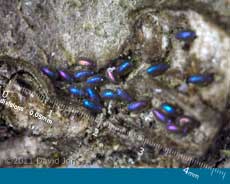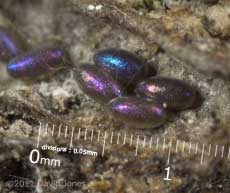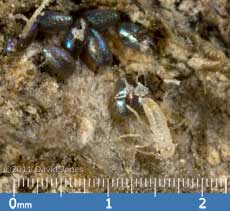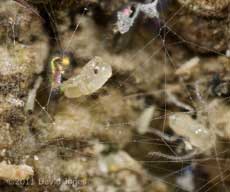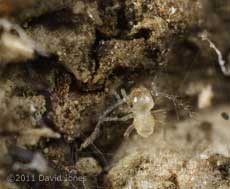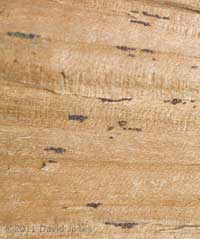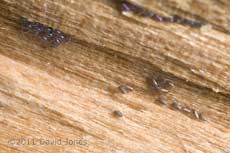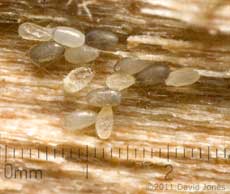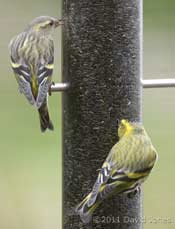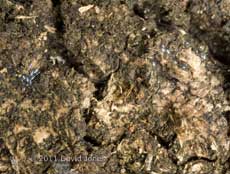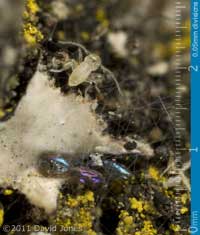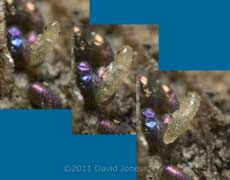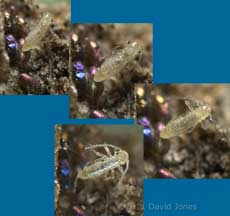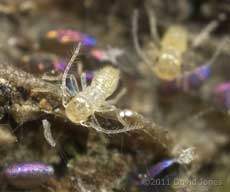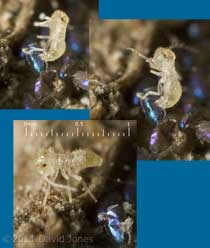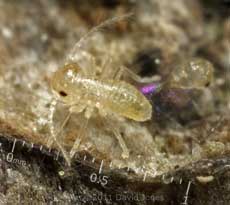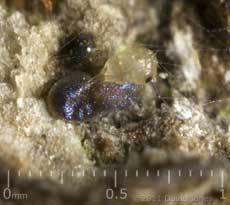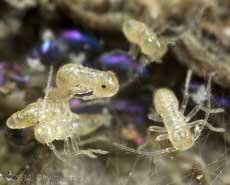Go to the last entry on this page .....Go to previous entry1 March - A happy St. David's Day to everyone - A grey start to the month, with temperature remaining below 5C for most of the day - at least it has stayed dry.
The first of our Daffodils actually opened four days ago.
3 March - The cold, dry spell continues, and this morning there was the first ice on the birdbath for over a month - and I'm still waiting for the frogs to make their first appearance this month. And with it below 2C at 10.40pm there is no sign of them tonight. Today's 'The Times' reports that the Met Office says that the South East of England has just suffered what may be its gloomiest winter ever, with 40% fewer hours of sunshine than average between December and the end of February. Despite the snow we had in December, rainfall was some 22% below average. I have just bought a new microscope graticule to use in my macrophotography, and its arrival spurred me into dusting off my camera bellows. It was fortunate that I did. On our veranda table there is a log with dozens of barkfly eggs on it. I have been checking it every couple of weeks through the winter and apart from a small number of adults and older nymphs that seemed to be over-wintering on the log the eggs remained intact.
I measured quite a few eggs and came up with dimensions of 0.45mm (sometimes very slightly longer) by 0.25mm wide.
I'm sometimes asked how I can be sure that the scales are accurate. What I do is to photograph the scale (in this case the new graticule) immediately after taking the actual photograph, using exactly the same camera/lens or camera/bellows/lens arrangement. This ensures that anything that is in focus in the picture is at the same scale as the image of the graticule. Then it's a matter of combining the two images before any size changes are made. Anyway, back to the barkfly eggs. As I checked the log this afternoon it wasn't long before I realized that quite a few eggs looked damaged. Then I spotted some very tiny nymphs. Over the last couple of weeks many young barkflies had hatched. I could see nymphs in the shelter of cracks in the bark, but it took ages to confirm that hatching is actually on ongoing process.
The first sighting that provided that confirmation was this nymph, still attached to an egg case. Note its slender body shape, more reminiscent of a ladybird larva at this stage. While it is longer than the egg (at around 0.7mm) Its body is just 0.175mm wide along most of its length, with the head being 0.2mm wide. I found a couple more nymphs like this one, but they had already wandered
away from their egg cases.
It would have been interesting to have kept the log in place in front of the camera to record progress but I decided that it was time to put it back outside.
While I cannot say for sure that they are all the same species, I only saw the 'slender' nymphs close to egg cases, so it seems very likely that body shape is just an initial stage when they emerge.
In an effort to improve my chances of confirming this, I have cut off the small area of bark on which the eggs in the first pictures are attached. It is now in a container outside and will be checked frequently over the days to come.
4 March - A bright day with an icy birdbath at the start of the day but with the temperature approaching 8C in the late morning before falling again. At 9.30pm its back down to below 3C. Again I have seen no frogs today, although at the warmest time of the day I did hear a single croak from the undergrowth! The mouse made an appearance around lunchtime. Nothing to report from the Great Tit box so far.
What surprised me this time was that the majority of egg clusters are on
the cut timber rather than the bark, and in this picture you can see
numerous groups more or less aligned with the grain of the timber.
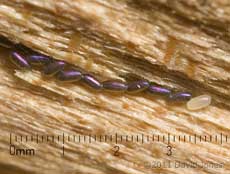 Just occasionally an egg cluster will include a much paler egg. Judging by the relative positions of the eggs in this cluster it appears that the while egg my be the most recently laid, posing the question will it darken over time? This log is now on my veranda table so that I can check it.
The presence of perfectly shaped eggs in various shades suggests that it could be a recently laid group, but if that is the case why are there several deformed eggs and one that has been opened (perhaps by a predator?). Looking closer at the picture I cannot see the dimpling that is normally visible on these eggs Another reason to keep checking the logs....
5 March - A day which started cold, just degree or so above freezing (no ice on the birdbath) and which remained cold despite some sunshine. Actually, the temperature was still rising after dark, reaching around 7C before dropping a bit so that it is just under 6C at 10 20pm. Just one daytime picture. It seems that the Siskins favour the mornings to visit the feeder, and soon after our breakfast time there were three of them here - as usual, two males and a single female.
I've had one of my tired days, so very little has been done, but this evening I spent some time (probably too long!) checking the barkfly eggs again.
Even in the large image you may need to look carefully to find the adult,
despite side lighting casting its shadow on the bark. Its abdomen has begun to take on the characteristic rounded shape and at just over 0.5mm in length it is certainly shorter than the newly emerged nymph I photographed on the 3rd. Below the nymph, the egg on the left of the group has a neat, round hole cut in it. Was this done by an emerging nymph or a predator? Most of the other empty eggs have rough tears.
No developments in the pond today, other than my topping up of the water! And the Great Tits continue to feed here without visiting the box.
6 March - Another partly sunny day with the temperature not getting above 7C during the day and dropping back below 3C tonight. Not surprisingly there is no frog activity in the ponds tonight, although I did spot two during the late morning - one dived as soon as I got near and the other waited until I was on my knees with my camera before it too headed for the deep! Much of the day was taken up with barkfly nymphs as hatching got underway for the eggs on the small piece of bark that I've been keeping in a container for the last three days. When I checked the bark at 10am there was no sign of activity, but things were different when I checked again at around 2pm. There were a couple of nymphs running around and at least one nymph in the process of emerging. Cursing myself for missing the start of this process I set up the camera and set about following that nymph's progress. This first sequence was taken at 2.37, 2.42 and 2.46pm.
Along with that, while in the first image the eyes appear flat, but the third image the simple eyes are clearly protruding form the head. Barkflies do not have the compound eyes characteristic of most insects. Instead they have two clusters of simple eyes set against a dark background.
With the body now fully emerged from the egg case (although still attached to it) you can now see some of the hairs on the body and after a pause of around four minutes the antennae sprung out away from under the body. Over the next three minutes the three pairs of legs were stretched out,
starting with the front pair before everything came to a stop for the next
couple of hours.
By the time the nymph broke free of the egg and walked away it was just after 6pm. Notice how its abdomen is now taking on the more characteristic bulbous appearance, with signs of a more clearly defined 'waist' between thorax and abdomen.
This sequence shows another nymph before and after breaking its link with its egg case. Notice the split in the egg case through which the nymph emerged. However, once again I'm puzzled by what appears to be a circular opening at the opposite end of the egg. Is it an opening? On another day I may resort a microscope to answer this question.
By now I was resorting to magnifications that caused problems with focusing and resolution. Nevertheless, the picture is clear enough to show a few details. First, the nymph is obviously lying on its back inside the egg. We are looking at the front of its head and you can see its antennae curving in towards the line of the slip in the case.
It was after 6pm by the time I took that last picture, and while it was tempting to continue into the evening I decided to stop the session and return the bark to the veranda. During the afternoon I had attempted to compensate for keeping the dish in a warm room by putting it on aluminium blocks that had been chilled in our freezer, using just a couple of relatively low power white LEDs for lighting during focusing. I also occasionally sprayed the dish with a very fine mist of rain water to maintain a degree of humidity around the bark. However, after four hours I felt that both the nymphs and I had probably had enough!
I suspect that by the end of tomorrow all the fertile eggs on this particular piece of bark will have given up their contents.
9 March - After two mornings when both bird bath and big pond were frozen over for a short time, the temperature at 8am this morning was 7C. It started bright and sunny (as were the last two days) but more cloud has arrived during the morning. Yesterday I saw two sure signs of Spring - my neighbour mowed his lawn for the first time, and a Magpie visited his Birch tree to collect one of its thinnest branches for its nest! Last night around 9pm, and with the air temperature at 7C and the water at 6C I saw seven frogs, including four back in the shallows. The forecast for the next couple of days suggests that temperatures will encourage more activity, but I see that we will return to low night-time temperatures again at the weekend. After the activities of the weekend I'm afraid that the last couple of days needed to be put on hold as my CFS raised its ugly head once more. It's annoying, extremely frustrating, but I just don't have the energy to compete with it. Today hasn't got off to a promising start, but hopefully I will be able to do something useful later on! Click on images to see larger version
|
|
